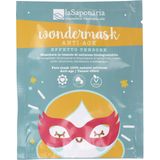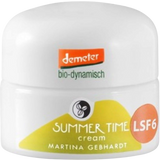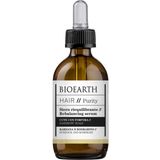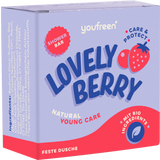"Nickel tested" Natural Cosmetics - What Does It Mean?
Many of the products sold at Ecco Verde are labelled as "nickel tested". This means that the products have been specifically tested for their nickel content, and that they are safe to for people with nickel allergies. These products contain very little trace of nickel (lower than 0.00001) and a allergic reaction is therefore unlikely (unfortunately, the risk can never be ruled out completely).
A large number of people suffer from nickel allergies. If you are allergic to nickel, it is essential to avoid using products containing nickel wherever possible. But, what causes these reactions and what are the symptoms thereof?
About nickel
Nickel is a shiny, silvery-white metal. It is one of the chemical elements and an important component of metal alloys. Therefore, nickel is widely used in the industrial branch (steel, etc.). Nickel-plated metals are harder and more resistant to corrosion, i.e. to rust.
Nickel is also detectable as a natural component in plants. It is a vital part of the plant's metabolism and, as a trace element, it is essential for our survival as humans. The average daily nickel requirement for adults is 0.2 to 0.5 mg. This requirement is usually met by the food we eat.
Nickel allergy: skin irritation
Sometimes, the skin reacts adversely to nickel. The immune system incorrectly classifies the nickel ions that have entered the body as harmful, resulting in the body going into over-defense mode.
Nickel allergy symptoms, in most cases, occur within 12 to 72 hours and are localized to the area that came into contact with the nickel.
- It mainly occurs through direct contact with the skin. For example, costume jewellery often contains nickel. Sweat has an acidic pH that dissolves the nickel ions, which then in turn penetrate the skin and the body.
- It can also occur after consuming foods that are high in nickel. A nickel allergy can therefore also be classified as a food allergy.
Globally, around 8% of people suffer from nickel allergies. Generally, industrialized countries are more affected than developing countries, as products containing nickel are used more widely. The awareness rate by country varies considerably. For example, in the United States, 35 to 40% of the population is allergic to nickel, compared to around 14% in France.
The causes
Nickel is vital for us humans as a trace element. However, if the dosage is too high, an allergy occurs. No one is born with an allergy to nickel. It always only occurs after too much contact with this metal.
As an alloy component, nickel is present in ...
- virtually all metallic objects (in reality, only titanium does not contain nickel),
- many jewellery (whether inexpensive or expensive),
- household items,
- mobile phones, etc.
However, the deciding factor is not the nickel content itself, but the amount released and absorbed by the body. The release of nickel ions is promoted by the following factors:
- preservatives
- acids
- sweat
- high temperatures
Nickel is also found in almost all foods. However, plant products generally contain more nickel than animal products. Food only contain their actual nickel content unlike it being absorbed through the skin, whereby the rate of release plays an important factor regarding allergie.
You should also be careful when choosing your kitchen utensils: nickel ions can escape the metal utensils adn accumulate in food in the case of very acidic foods, such as sauerkraut or tomato sauce, for example. Thus, dishes that would not normally be classified as being suspicious of can also cause allergic reactions.
Risk of disease can also be favoured by various factors. Thus, factors that weaken the natural skin barrier increase the risk of disease, such as:
- bacteria
- chemical products
- inflammation
- UV rays
Symptoms
Eczema on the skin is the most common symptom of a nickel allergy. The areas most often affected are:
- Hands and fingers -> rings, door handles, keyboards ...
- Navel -> pants button, belt buckle, piercing
- Cuffs -> bracelets, watches
- Ears -> glasses, earrings ...
- Mouth -> orthopedic appliances or dentures
- Armpits -> nickel ions ingested by food, and then excreted as perspiration by the sweat glands
Dermatitis is characterized by redness, itching, and swelling. In addition, oozing blisters or pustules may form.
If you have any doubts about a possible nickel allergy, it is essential to perform an allergy test and ask your doctor which products to avoid.
A "Nickel Tested" filter can be found on the Ecco Verde website: it allows you to filter the results by simply displaying the products which have been tested for their nickel content by the manufacturers, and which fall into the category of products normally harmless to people with a nickel allergy (due to extremely low nickel content).
Some brands also specialize in products designed for sensitive and allergic skin, such as PAI Skincare or the Alva Sensitive range. You can also rely on the BDIH label, a certification body which guarantees that cosmetic ingredients do not contain mineral oil - hence, the nickel content in the product is very low.
For safety reasons, if you are concerned about nickel allergies or have doubts about it, before ordering new products that you are not familiar with yet: it is recommended to try them in mini-size format or in travel-size formats, when available, first to see how the skin reacts. In all cases, test the product on a very small area of skin before initial application.
Latest reviews
-
 3.9 (11)
3.9 (11)La Saponaria Wonder Mask: Anti-Aging Sheet Mask, 10 ml
- For mature skin
- Enhances skin radiance
- Biodegradable cellulose
£4.15 (£415.00 / l)Delivery by January 07
-
 4.5 (13)
4.5 (13)Martina Gebhardt Summer Time Cream SPF 6, 15 ml
-5%- Suitable for all skin types
- Soothes & strengthens
- Guards against environmental influences
£9.15 £9.65 (£610.00 / l)Delivery by January 07
-
 4.4 (27)
4.4 (27)Bioearth Balancing Serum, 50 ml
- Use on a scalp prone to dandruff
- Soothing properties
- Fast-absorbing without the greasiness
£14.50 (£290.00 / l)Delivery by January 07
-
 5.0 (3)
5.0 (3)youfreen Lovely Berry Shower Bar , 75 g
- For all skin types
- Provides suppleness
- Sustainable & environmentally friendly
£5.75 (£76.67 / kg)Delivery by January 07
Magazine Articles:
Discover Ecco Verde:
-
Great Britain: Free standard delivery from £69.90
-
Free
returns -
Get at least 1 free sample
per order More than 19.350 products


